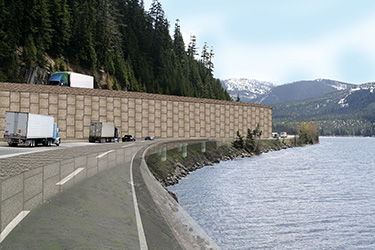|
Subscribe / Renew |
|
|
Contact Us |
|
| ► Subscribe to our Free Weekly Newsletter | |
| home | Welcome, sign in or click here to subscribe. | login |
Construction
| |
May 7, 2014
Atkinson says changes to I-90 at Snoqualmie Pass won't cost more
Journal Construction Editor
Guy F. Atkinson Construction says it won't cost more to widen a three-mile section of Interstate 90 over Snoqualmie Pass that it is building for the Washington State Department of Transportation.
The project has required some redesigns of the bridge and alignment changes due to the tricky terrain. Those changes have WSDOT recalculating the cost and schedule.
Atkinson Vice President Bob Adams says the changes will not increase the company's $177 million contract to do the work. “It appears at this time the contract will be built at the original amount,” he said.
Last month WSDOT indicated that costs could increase, but in a recent email the agency said it is “still working with the contractor and their designers to complete this portion of Phase 1 within the original budget and timeline.”
Adams said they are working on the schedule and don't have a completion date at this time. WSDOT previously said the date moved from 2017 to 2019, but the agency now says 2019 is a worst-case scenario and expects to complete it in 2018.
Atkinson's work involves widening the freeway from two to three lanes in each direction, which at one point required building four small bridges and three large ones.
Part of WSDOT's original plan was to replace an aging snowshed that covered half the freeway with a larger one that would protect all six future lanes from avalanches.
Atkinson came up with a money-saving idea to substitute the snowshed with two tall bridges that allow avalanches to pass below them. It brought in Jacobs Engineering Group to help design the bridges.
WSDOT signed off on the avalanche bridges, which are expected to cost the same as the snowshed but save $50 million over 70 years in operation and maintenance costs due to recent changes in the national Life Safety Code that would affect a snowshed.
In an email, a WSDOT spokeswoman wrote it took a little over a year to get the bridge design approved and to go through the environmental process.
The project's third big bridge — called the Slide Curve Bridge — became a big challenge.
Adams described the proposed site as a tough spot, squeezed between a hillside and Lake Keechelus.
Slide Curve Bridge was to have been built east of the old snowshed, with the eastbound lanes extending a little over the lake. In the summer of 2012 crews had difficulty installing soil nails for one of the bridge's eastbound retaining walls because the holes would not hold grout due to unexpected voids in the subsurface.
The problem continued into the summer 2013 construction season, and so WSDOT stopped the work last September and asked Atkinson to redesign the wall.
Two months later, Atkinson and Jacobs came up with four options: secant piles, micro-piles and two different alignments.
The team chose the new alignment that shifts the road closer to the hillside and builds a structural earth wall abutting the eastbound lanes along the lake. The new alignment raises the westbound lanes to minimize rock cuts. It also eliminates Slide Curve Bridge and its associated retaining walls, including the problematic soil nail wall.
“We are certain that this change won't add to the contract value,” Adams said.
Atkinson and Jacobs' redesign benefited from a revision to geotechnical design guidelines that was published last October by the American Association of State Highway and Transportation Officials and incorporated into WSDOT's geotechnical design manual. The revision allows wall systems less than 30 feet tall to be placed on the ground instead of into bedrock.
Adams said the new design is ready and the structural earth wall will be built between July 1 and Oct. 1, when the water level is lowest on Lake Keechelus.
This summer Atkinson will also start construction of the avalanche bridge foundations. Adams said they hope to have the eastbound bridge finished by the end of 2016, and then shift all I-90 traffic onto it and the three miles of new eastbound lanes while they build the westbound section.
Adams said switching to the eastbound lanes will move the freeway and motorists out of the way of avalanches.
Crews are also installing snow net systems above the freeway that act as avalanche barriers. The nets are suspended between 11.5-foot poles that are anchored into the hillside. They will catch snow and block it from flowing downhill.
Hi-Tech Rockfall Construction of Forest Grove, Ore., is installing the nets and expects to finish in October. Hi-Tech's website says the nets are the first avalanche barriers to be installed along an interstate highway in the U.S.
Crews are also going after loose rock. Workers on ropes are using hand tools and air bags to remove precarious rock. They also are using drills suspended on ropes to install bolts to stabilize rock faces.
Adams said his company is working hard to reduce delays, while dealing with the short construction season in the mountains.
Benjamin Minnick can be
reached by email or by phone
at (206) 622-8272.



